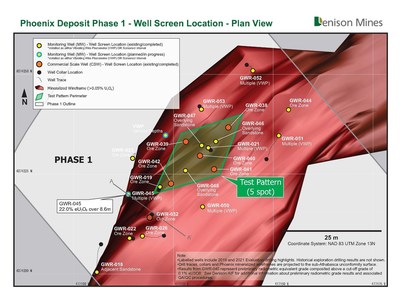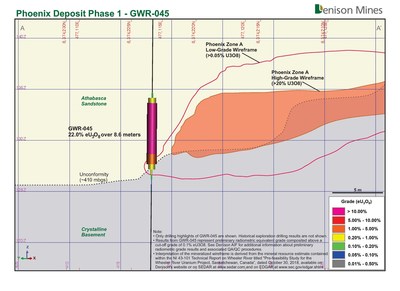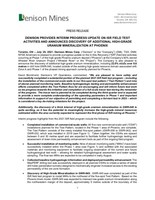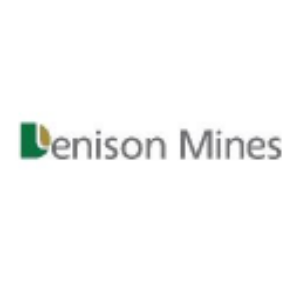Denison Provides Interim Progress Update on ISR Field Test Activities and Announces Discovery of Additional High-Grade Uranium Mineralization at Phoenix
Denison Mines Corp. (TSX: DML, NYSE American: DNN) provided a progress update on its In-Situ Recovery (ISR) field test at the Phoenix uranium deposit, revealing additional high-grade mineralization of 22.0% eU3O8 over 8.6 metres in drill hole GWR-045. All five commercial-scale wells for the ISR test have been successfully installed, alongside nine monitoring wells. Plans for the remainder of 2021 include conducting multi-day pump tests and ion tracer tests to assess permeability and validate models of sub-surface pathways.
- Discovery of high-grade uranium mineralization of 22.0% eU3O8 over 8.6 metres in drill hole GWR-045, indicating potential resource expansion.
- Successful installation of five commercial-scale wells and nine monitoring wells, facilitating future hydrogeological assessments.
- Possible disruptions to the 2021 ISR field program due to COVID-19-related restrictions.
Insights
Analyzing...
TORONTO, July 29, 2021 /PRNewswire/ - Denison Mines Corp. ("Denison" or the "Company") (TSX: DML) (NYSE American: DNN) is pleased to provide a progress update on the In-Situ Recovery ("ISR") field test activities occurring at Phase 1 of the high-grade Phoenix uranium deposit ("Phoenix") at the Company's
David Bronkhorst, Denison's VP Operations, commented, "We are pleased to have safely and successfully completed a substantial portion of the planned 2021 ISR field test program – including the installation of the commercial-scale wells in our five-spot test pattern ("Test Pattern") and nine of eleven planned monitoring wells. Baseline hydrogeologic testing and permeability enhancement efforts completed within the Test Pattern thus far are encouraging and will inform future test work as we progress towards the initiation and completion of a full-scale tracer test during the remainder of the program. The tracer test is planned to be completed during the third quarter and is expected to provide a more complete understanding of the operating parameters in Phase 1 and important information in support of our objective of permitting and completing a lixiviant test in 2022 – which is considered a key de-risking milestone for the project.
Additionally, the discovery of a thick interval of high-grade uranium mineralization in GWR-045 is quite exciting, as it has the potential to meaningfully increase the high-grade mineral resources estimated within the area currently expected to represent the first phase of ISR mining at Phoenix."
Interim progress highlights from the 2021 ISR field program include the following:
- Completed installation of commercial-scale wells: All five new commercial-scale well ("CSW") installations planned for the Test Pattern, located in the Phase 1 area of Phoenix, are complete. The Test Pattern consists of the newly installed five-spot pattern (GWR-038 to GWR-042), and GWR-032, which was installed in 2019 (see Figure 1). Taken together, the CSWs are spaced between 5 and 30 metres apart and are expected to facilitate further hydrogeologic testing and assessment of down-hole permeability enhancement tools as part of the ongoing field program.
- Successful installation of monitoring wells: Nine of eleven monitoring wells ("MWs") have been successfully installed within the Phase 1 area (see Figure 1) and outfitted with the associated materials and monitoring equipment to facilitate ongoing observation of the current and future hydrogeological test work – allowing for detailed hydrogeological assessment and water quality sampling. The final two MWs are expected to be completed in early August.
- Collected baseline hydrogeologic information and deployed permeability enhancement: The MaxPERF drilling tool was successfully deployed in all planned CSWs to create a series of lateral drill holes (penetration tunnels) designed to mechanically engineer increased access to the existing permeability of the ore zone formation.
- Discovery of High-Grade Mineralization in GWR-045: GWR-045 was completed as part of the ISR field test program to install MWs to the northwest of the five-spot Test Pattern. Based on the Phoenix block model, GWR-045 was expected to intersect low-grade uranium mineralization along the northwestern margin of the deposit, approximately 5 metres outside of the boundary of the Phoenix Zone A high-grade resource domain. The drill hole, however, intersected a thick interval of high-grade unconformity-associated uranium mineralization grading
22.0% eU3O8 over 8.6 metres (see Figures 1 and 2; Table 1). The high-grade mineralization intersected by GWR-045 remains open to the northwest, representing an area for further exploration and potential mineral resource expansion of Phoenix. Denison's exploration team is currently incorporating the results of GWR-045 into the Phoenix geological model to evaluate the potential to extend the high-grade domain with additional exploration drilling in the Phase 1 area of Phoenix.
Table 1 – GWR-045 Mineralized Intersection | ||||
Drill Hole | From (m) | To (m) | Length (m)4 | eU3O8 (%)1,2,3 |
GWR-045 | 406.95 | 415.55 | 8.6 | 22.0 |
Notes: |
1. eU3O8 is radiometric equivalent U3O8 derived from a calibrated total gamma down-hole probe. |
2. Composited above a cut-off grade of |
3. Composited using a 1.0 metre minimum mineralization thickness and 1.0 metre maximum waste |
4. The stated length is interpreted to represent true thickness as the drill hole is oriented vertically, and the unconformity mineralization is interpreted to lie horizontally |
Activities Planned for Remainder of 2021 ISR Field Program
Once the final two MWs are completed, the Test Pattern will be ready for additional hydrogeologic test work, including the following planned activities:
- Multi-day pump and injection tests to be conducted on the full-scale Test Pattern. These tests are intended to assess the Test Pattern's total permeability, and support an ongoing assessment of the ability of various permeability enhancement tools to normalize the varying levels of permeability associated with the natural fracture/structure network of the deposit;
- Ion tracer tests will be conducted by injecting and recovering solution with dissolved inorganic salts throughout the full-scale Test Pattern. This process is expected to (1) establish breakthrough times for each CSW, with injection from the centre well in the Test Pattern and recovery from the outer ring wells, and (2) confirm modelling of sub-surface pathways. Taken together, this test is expected to provide a more complete understanding of the hydrogeologic characteristics expected throughout Phase 1 and the necessary datasets for the design and permitting of a lixiviant test planned to make use of the same Test Pattern in 2022;
- Deployment and evaluation of additional permeability enhancement techniques based on individual well characteristics and associated hydrogeological assessments; and
- Extensive collection and analysis of permeameter samples from new and historic drill core for the assessment of matrix permeability spatially distributed throughout the areas representative of all of the mining phases planned for Phoenix.
All test work in 2021 will be conducted using site groundwater. Following the field tests and associated data collection, detailed hydrogeological and geochemical modelling of the test data will be carried out by various Qualified Persons ("QPs").
COVID-19
The Company is committed to ensuring that the Wheeler River site is a safe operating environment for its staff and contractors and that the Company's field activities do not compromise the health and safety of the residents of northern Saskatchewan. In 2020, the Company's Occupational Health and Safety Committee in Saskatoon developed a comprehensive guide for the safe resumption of work at Wheeler River. The protocols consider the unique health and safety risks associated with operating a remote work camp amidst the ongoing COVID-19 pandemic. Public health guidelines and best practices (including testing) have been incorporated into the Company's protocols.
Despite the Company's current intentions, it is possible that the 2021 ISR field program may be disrupted by the continuously evolving social and/or economic disruptions associated with the COVID-19 pandemic, which are outside of the control of the Company – for example, provincial or local travel restrictions, or changing public health guidelines, could impact the ability of Company or contractor staff to attend to
the site.
Use of Radiometric Equivalent Grades
The Company typically reports results as preliminary radiometric equivalent grades ("eU3O8"), derived from a calibrated downhole total gamma probe, during active exploration programs and subsequently reports definitive assay grades following sampling and chemical analysis of the mineralized drill core. In the case where core recovery within a mineralized intersection is less than
About Phoenix Phase 1
Phase 1 of Phoenix is estimated to contain approximately 22.2 million pounds U3O8 (37,242 tonnes at
About Wheeler River
Wheeler River is the largest undeveloped uranium project in the infrastructure rich eastern portion of the Athabasca Basin region, in northern Saskatchewan – including combined Indicated Mineral Resources of 132.1 million pounds U3O8 (1,809,000 tonnes at an average grade of
A Pre-Feasibility Study ("PFS") was completed for Wheeler River in late 2018, considering the potential economic merit of developing the Phoenix deposit as an ISR operation and the Gryphon deposit as a conventional underground mining operation. Taken together, the project is estimated to have mine production of 109.4 million pounds U3O8 over a 14-year mine life, with a base case pre-tax NPV of
Further details regarding the PFS, including additional scientific and technical information, as well as after-tax results attributable to Denison's ownership interest, are described in greater detail in the NI 43-101 Technical Report titled "Pre-feasibility Study for the Wheeler River Uranium Project, Saskatchewan, Canada" dated October 30, 2018 with an effective date of September 24, 2018. A copy of this report is available on Denison's website and under its profile on SEDAR at www.sedar.com and on EDGAR at www.sec.gov/edgar.shtml.
Denison suspended certain activities at Wheeler River during 2020, including the EA process, which is on the critical path to achieving the project development schedule outlined in the PFS. While the EA process has resumed, the Company is not currently able to estimate the impact to the project development schedule outlined in the PFS, and users are cautioned against relying on the schedule estimates provided therein, including with respect to the start of pre-production activities in 2021 and first production in 2024.
About Denison
Denison is a uranium exploration and development company with interests focused in the Athabasca Basin region of northern Saskatchewan, Canada. In addition to the Wheeler River project, Denison's interests in the Athabasca Basin include a
Denison is also engaged in mine decommissioning and environmental services through its Closed Mines group (formerly Denison Environmental Services), which manages Denison's Elliot Lake reclamation projects and provides post-closure mine care and maintenance services to a variety of industry and government clients.
Follow Denison on Twitter @DenisonMinesCo
Qualified Persons
The technical information contained in this release has been reviewed and approved by Mr. David Bronkhorst, P.Eng, Denison's Vice President, Operations and Mr. Andrew Yackulic, P. Geo., Denison's Director, Exploration, who are Qualified Persons in accordance with the requirements of NI 43-101.
Cautionary Statement Regarding Forward-Looking Statements
Certain information contained in this news release constitutes 'forward-looking information', within the meaning of the applicable United States and Canadian legislation, concerning the business, operations and financial performance and condition of Denison.
Generally, these forward-looking statements can be identified by the use of forward-looking terminology such as 'plans', 'expects', 'budget', 'scheduled', 'estimates', 'forecasts', 'intends', 'anticipates', or 'believes', or the negatives and/or variations of such words and phrases, or state that certain actions, events or results 'may', 'could', 'would', 'might' or 'will be taken', 'occur', 'be achieved' or 'has the potential to'.
In particular, this news release contains forward-looking information pertaining to the following: the planned scope, elements, and objectives of the 2021 ISR field programs, including the drilling of CSWs and MWs and development and objectives of the Test Pattern; other evaluation activities, including a planned future lixiviant test; the results of the PFS and expectations with respect thereto; expectations with respect to phased development, and the estimates of reserves in each such phase; other development and expansion plans and objectives, including plans for an environmental assessment and a feasibility study; and expectations regarding its joint venture ownership interests and the continuity of its agreements with its partners.
Forward looking statements are based on the opinions and estimates of management as of the date such statements are made, and they are subject to known and unknown risks, uncertainties and other factors that may cause the actual results, level of activity, performance or achievements of Denison to be materially different from those expressed or implied by such forward-looking statements. For example, the modelling and assumptions upon which the work plans are based may not be maintained after further testing or be representative of actual conditions within the Phoenix deposit. In addition, Denison may decide or otherwise be required to discontinue its field test activities or other testing, evaluation and development work at Wheeler River if it is unable to maintain or otherwise secure the necessary resources (such as testing facilities, capital funding, regulatory approvals, etc.) or operations are otherwise affected by COVID-19 and its potentially far-reaching impacts. Denison believes that the expectations reflected in this forward-looking information are reasonable but no assurance can be given that these expectations will prove to be accurate and results may differ materially from those anticipated in this forward-looking information. For a discussion in respect of risks and other factors that could influence forward-looking events, please refer to the factors discussed in Denison's Annual Information Form dated March 26, 2021 or subsequent quarterly financial reports under the heading 'Risk Factors'. These factors are not, and should not be construed as being exhaustive.
Accordingly, readers should not place undue reliance on forward-looking statements. The forward-looking information contained in this news release is expressly qualified by this cautionary statement. Any forward-looking information and the assumptions made with respect thereto speaks only as of the date of this news release. Denison does not undertake any obligation to publicly update or revise any forward-looking information after the date of this news release to conform such information to actual results or to changes in Denison's expectations except as otherwise required by applicable legislation.
Cautionary Note to United States Investors Concerning Estimates of Measured, Indicated and Inferred Mineral Resources and Probable Mineral Reserves: This press release may use the terms 'measured', 'indicated' and 'inferred' mineral resources. United States investors are advised that while such terms have been prepared in accordance with the definition standards on mineral reserves of the Canadian Institute of Mining, Metallurgy and Petroleum referred to in Canadian National Instrument 43-101 Mineral Disclosure Standards ('NI 43-101') and are recognized and required by Canadian regulations, these terms are not defined under Industry Guide 7 under the United States Securities Act and, until recently, have not been permitted to be used in reports and registration statements filed with the United States Securities and Exchange Commission ('SEC'). 'Inferred mineral resources' have a great amount of uncertainty as to their existence, and as to their economic and legal feasibility. It cannot be assumed that all or any part of an inferred mineral resource will ever be upgraded to a higher category. Under Canadian rules, estimates of inferred mineral resources may not form the basis of feasibility or other economic studies. United States investors are cautioned not to assume that all or any part of measured or indicated mineral resources will ever be converted into mineral reserves. United States investors are also cautioned not to assume that all or any part of an inferred mineral resource exists, or is economically or legally mineable. In addition, the terms "mineral reserve", "proven mineral reserve" and "probable mineral reserve" for the purposes of NI 43-101 differ from the definitions and allowable usage in Industry Guide 7. Effective February 2019, the SEC adopted amendments to its disclosure rules to modernize the mineral property disclosure requirements for issuers whose securities are registered with the SEC under the Exchange Act and as a result, the SEC now recognizes estimates of "measured mineral resources", "indicated mineral resources" and "inferred mineral resources". In addition, the SEC has amended its definitions of "proven mineral reserves" and "probable mineral reserves" to be "substantially similar" to the corresponding definitions under the CIM Standards, as required under NI 43-101. However, information regarding mineral resources or mineral reserves in Denison's disclosure may not be comparable to similar information made public by United States companies.
Figure 1: Plan Map Showing Location of Phoenix Deposit (Phase 1) – ISR Test Pattern
![]() View original content to download multimedia:https://www.prnewswire.com/news-releases/denison-provides-interim-progress-update-on-isr-field-test-activities-and-announces-discovery-of-additional-high-grade-uranium-mineralization-at-phoenix-301344121.html
View original content to download multimedia:https://www.prnewswire.com/news-releases/denison-provides-interim-progress-update-on-isr-field-test-activities-and-announces-discovery-of-additional-high-grade-uranium-mineralization-at-phoenix-301344121.html
SOURCE Denison Mines Corp.











